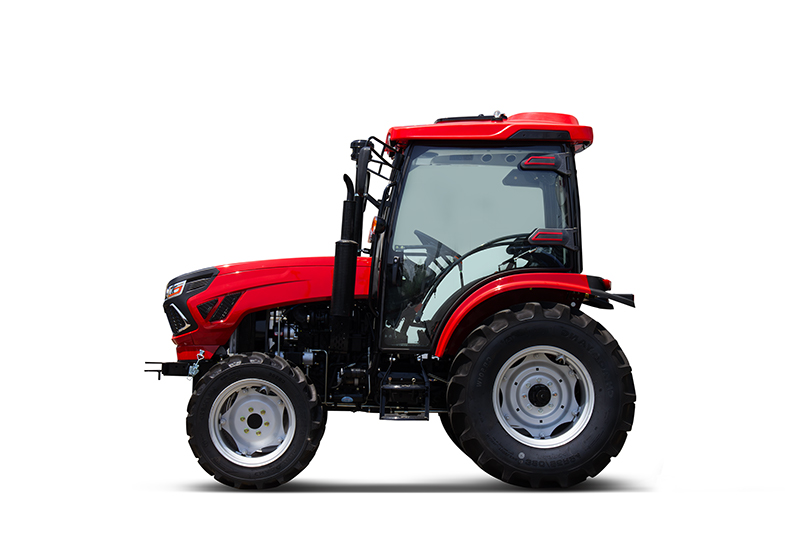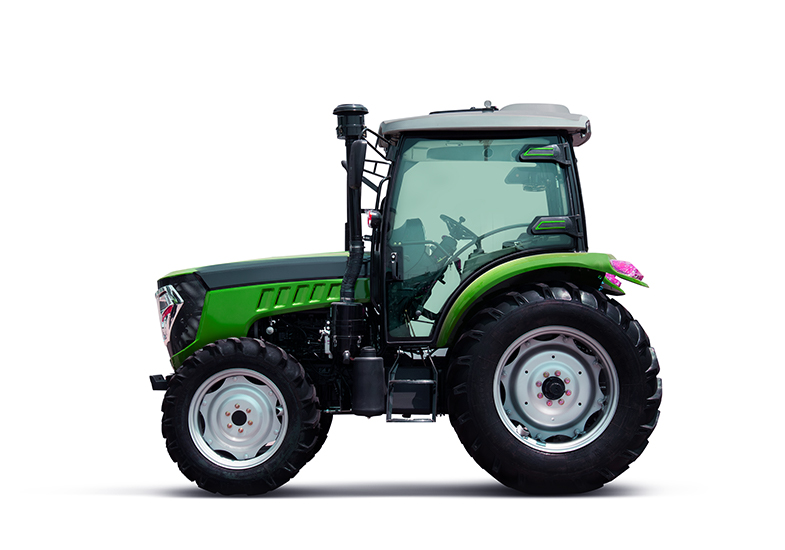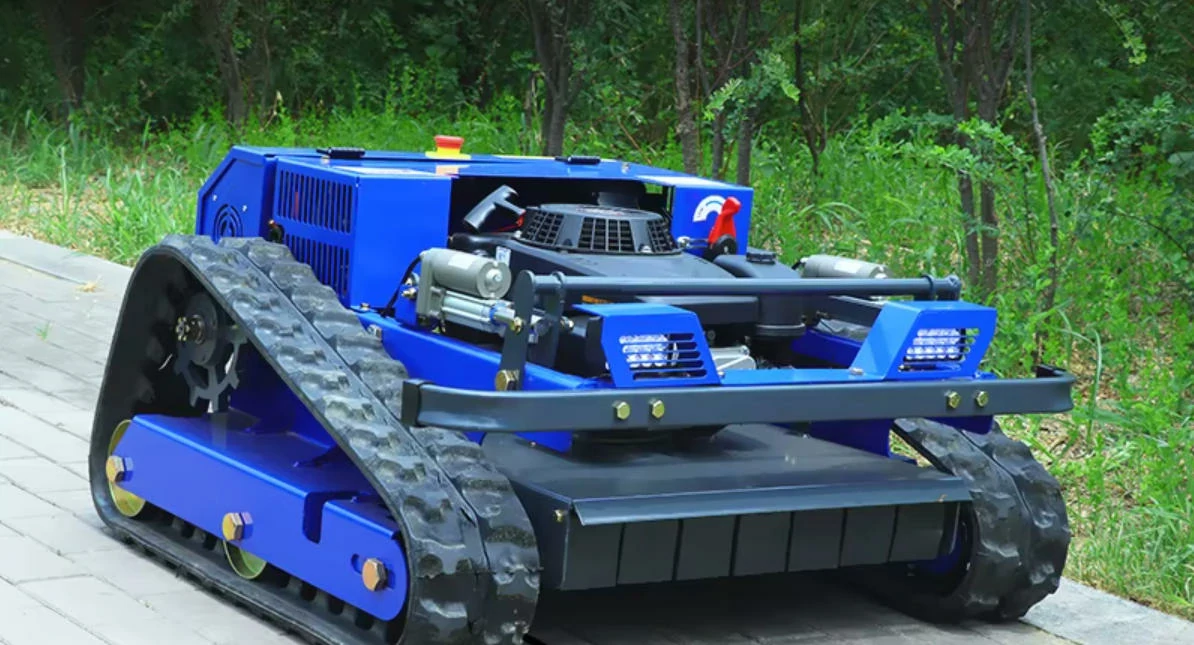If you have a big yard with lots of thick grass and hills, a bush mower is probably your best bet. For smaller lawns with fewer obstacles, you might want a simpler push mower. Think about your property size, layout, and how much work you want to put into maintenance and cost.
Key Takeaways
Choose a bush mower for large yards with thick grass and steep terrain. It handles tough jobs and keeps you safe with remote control options.
Opt for a push mower if you have a small, flat lawn. It is lightweight, easy to maneuver, and requires less maintenance.
Consider your yard size, terrain, and vegetation type before buying a mower. Matching the right mower to your yard ensures efficient mowing and a healthy lawn.
Bush mower overview

Definition
A bush mower is a powerful machine built to handle tough jobs. You use this mower when you face thick grass, brush, or even small trees. Unlike a regular riding mower or a robotic lawn mower, a bush mower can cut through overgrown areas with ease. The DeepKron R55 R/C Lawn Mower stands out as a top choice. This robotic mower lets you control it from a distance, so you stay safe while it works on steep slopes or rough ground. It has a strong engine and can handle hills up to 45 degrees.
Tip: If you have a lot of overgrown land or uneven ground, a bush mower like the DeepKron R55 makes mowing much easier.
Best uses
You will find a bush mower most helpful in places where a regular riding mower or robotic mower just cannot keep up. Here are some common uses:
Application Type | Description |
|---|---|
Keeping grass and brush clear along roads. | |
Right-of-way maintenance | Clearing utility paths and corridors. |
Site preparation | Getting land ready for building or landscaping. |
Fire control | Cutting down brush to prevent wildfires. |
Fence line maintenance | Removing overgrown plants near fences. |
Trail creation and maintenance | Making and keeping up paths in wild areas. |
You can also use a bush mower for clearing fields, maintaining large properties, or tackling overgrown lots.
Pros and cons
Let’s look at what makes a bush mower a smart pick—and where it might not fit:
Pros:
Handles thick, overgrown vegetation and brush
Works well on steep slopes and rough terrain
Robotic control keeps you safe and saves effort
Durable and built for heavy-duty work
Cons:
Not ideal for small, flat lawns
Costs more than a basic riding mower
A bush mower, especially a robotic model like the DeepKron R55, gives you the power and control you need for big, tough jobs.
Push lawn mower basics

What is a push mower
When you think about taking care of your lawn, a push mower is probably the first thing that comes to mind. This type of lawn mower relies on your strength to move it forward. You grip the handle, walk behind, and guide the mower across your lawn. Unlike a riding mower or a robotic mower, you do all the pushing. Push mowers have smaller cutting decks, so you might need more passes to cover your lawn, but they are much lighter than other types of lawn mowers. You can easily steer them around trees, flower beds, or any obstacles in your yard.
Tip: Push mowers are simple, with fewer parts than a riding mower or robotic mower. That means less maintenance and fewer things that can go wrong.
Push mowers need your effort to move.
They weigh less, usually between 35 and 65 pounds.
You get more control, especially in tight spots on your lawn.
Ideal lawn types
Push mowers work best for small to medium-sized lawns. If your lawn is flat and doesn’t have many bumps, you’ll find mowing easy. These mowers shine when you mow your lawn regularly. If you want a quiet, eco-friendly way to keep your lawn neat, a push mower is a great choice. You won’t get the same results on a huge or hilly lawn as you would with a bush mower, riding mower, or robotic mower.
Perfect for flat lawns with few obstacles
Great for regular lawn care
Pros and cons
Let’s break down the main pros and cons of push lawn mowers compared to other types of lawn mowers:
Pros | Cons |
|---|---|
You do all the pushing | |
Simple to maintain and affordable | Not ideal for large or hilly lawns |
Quiet and eco-friendly | Takes longer on bigger lawns |
Easy to maneuver around lawn obstacles | Smaller cutting deck |
You’ll spend less on maintenance—usually $20 to $45 per year. Sharpening the blade costs just a few dollars. If you want a budget-friendly way to keep your lawn looking sharp, a push mower is hard to beat.
Key factors for choosing a mower
Choosing the right lawn mower for your yard can feel tricky. You want a mower that matches your lawn size, terrain, grass type, and budget. Let’s break down the main things you should think about before you buy.
Yard size
The size of your lawn makes a big difference. If you have a small lawn, you can use a push lawn mower or even a reel mower. These mowers work best for small residential lawns and give you more control over your grass. If your yard is big, you might need a riding lawn mower or a robotic mower. Large commercial properties need more power and efficiency, so riding mowers, lawn tractors, or zero-turn mowers fit best.
Here’s a quick table to help you match your lawn size to the right mower:
Recommended Mower Types | |
|---|---|
Small Residential Lawns | Push lawn mowers, reel lawn mowers |
Large Commercial Properties | Riding lawn mowers, lawn tractors, zero-turn mowers |
If your property is between 1/3 acre and 3 acres, a two-wheel-steer mower works well. For lawns over 3 acres, a four-wheel-steer mower gives you better control and efficiency.
Tip: Measure your lawn before you shop. You’ll save time and money by picking the right mower for your grass.
Terrain
Your lawn’s terrain affects how easy it is to mow. Flat lawns are simple. You can use a push lawn mower or a trimmer for tight spots. If your yard has hills, slopes, or rough ground, you need a mower that can handle tough terrain. Bush mowers, like the DeepKron R55 R/C Lawn Mower, work well on steep slopes and uneven grass. Riding mowers also help with big, bumpy lawns.
If you have lots of obstacles, like trees or flower beds, look for a mower with good maneuverability. Robotic mowers can handle complex layouts and save you effort.
Note: For steep slopes, always check the mower’s slope rating. The DeepKron R55 can handle slopes up to 45 degrees, making it a safe choice for hilly lawns.
Vegetation
The type of grass and plants in your yard matters. If you have thick grass, weeds, or brush, you need a mower that can cut through tough vegetation. Bush mowers and rotary cutters work best for large areas with dense grass. Flail mowers are great for ditches, orchards, and places with uneven terrain. Finish mowers give your lawn a smooth look but don’t handle thick grass well.
Mower Type | Suitable For | Notes |
|---|---|---|
Rotary Cutters | Large areas with thick vegetation | Can handle uneven terrain and leaves rough surfaces. |
Finish Mowers | Lawns, parks, and golf courses | Not effective for thicker vegetation, leaves a smooth finish. |
Flail Mowers | Ditches, right-of-ways, orchards, and vineyards | Cuts in both directions, ideal for dense material and uneven terrain. |
If you want a healthy lawn, pick a mower that matches your grass type. Use a trimmer for edges and tight spots. Keep your grass height even for the best results.
Tips: For thick grass, use a bush mower or rotary cutter. For regular lawn care, a push lawn mower or finish mower works best.
Maintenance
Every lawn mower needs regular maintenance to keep it running smoothly. Push lawn mowers are simple and easy to care for. You just check for loose parts, clean off grass clippings, and sharpen the blade. Bush mowers need more attention because they work harder and cut tougher grass.
Here’s a quick list of basic maintenance steps:
Get the mower ready: Check for loose fasteners, make sure wheels turn freely, and check oil level.
Clean the mower: Brush off clippings, empty the grass catcher, and clean the underside.
Winterize a push mower: Check the blade, lubricate the engine cylinder, and inspect moving parts.
Store the mower: Make sure it’s clean, cool, and dry before you put it away.
Tips: Clean your lawn mower after every use. Sharpen the blade often for the best mowing height and healthy lawn. Follow the manufacturer’s lawn mowing tips for longer life and better efficiency.
DeepKron makes maintenance easier with compact designs and easy-access parts. If you need help, their customer support team is ready to answer your questions.
Budget
Your budget plays a big role in your choice. Push lawn mowers cost less and work well for small lawns. Riding mowers and bush mowers cost more but save you time on big lawns. Robotic mowers offer convenience but come with a higher price tag.
Think about the long-term costs. Maintenance, repairs, and fuel add up over time. DeepKron offers reliable lawn mowers with strong warranties. You get coverage for structural defects, component defects, and electrical failures (not caused by misuse). Free technical consultation is available during the warranty period.
Warranty Coverage | Details |
|---|---|
Structural defects | Covered |
Component defects | Covered |
Electrical failures | Covered (non-human causes) |
Free technical consultation | Available during warranty period |
Warranty duration | Frame & structure: 12 months |
You can reach DeepKron’s support team by phone at +1 646-234-0488 or email at [email protected]. They help you keep your mower running smoothly and answer any questions about lawn care tips or maintenance.
Tips: Set your budget before you shop. Look for a mower that fits your lawn size, grass type, and mowing needs. Don’t forget to factor in maintenance and warranty support.
How to mow tall grass
Preparation
Getting ready to tackle mowing tall grass makes the job easier and safer. You want your lawn to look neat, even if it’s overgrown. Here’s how to prepare:
Check your lawn for rocks, sticks, or toys. Remove anything that could damage your mower or get in the way.
Make sure your mower blades are sharp. Fresh blades help with cutting tall grass and keep your lawn healthy.
Fill up with fresh fuel and top off the oil. A well-serviced mower works better, especially when mowing tall grass.
If your grass is very overgrown, use a trimmer first. Cut the grass down by half before you mow. This step helps your mower avoid overheating.
Tip: The DeepKron R55 R/C Lawn Mower handles tall grass and steep slopes with ease. Its strong engine and adjustable cutting height make mowing tall grass less stressful.
Mowing tips
You want your lawn to look great after mowing tall grass. Try these tips:
Follow the one-third rule. Never cut more than one-third of the grass blade at once. This keeps your lawn healthy and helps prevent stress.
Set your mower to a higher cutting height. Mow slowly and take your time. Tall grass needs gentle care.
Mow in stages. Wait about a week between each mowing session if your grass is very overgrown.
Use a mower with good maneuverability. The DeepKron R55 R/C Lawn Mower moves easily over rough terrain and thick grass.
Note: Mowing tall grass in stages helps your lawn recover and reduces the risk of pests or disease.
Safety
Safety matters when mowing tall grass, especially on slopes or uneven ground. Here’s what you should do:
Watch out for wet grass. Rain or dew makes the lawn slippery and increases risk.
Read your mower’s manual. Know how your mower works on slopes.
Mow across slopes, not up and down. This gives you better control.
Go slow and look for obstacles. If you feel unsafe, stop mowing.
Use safety features like emergency stop and rollover protection.
Tip: The DeepKron R55 R/C Lawn Mower lets you mow from a distance, keeping you safe while mowing tall grass on steep hills.
Decision guide
Quick checklist
Before you pick a mower, run through this checklist. It helps you match your yard and mowing needs to the right tool. Take a look at the table below:
Criteria | Description |
|---|---|
Area size | Small lawns need simple mowers. Large lawns need more power to mow all the grass. |
Mower size | Big mowers work fast but can be hard in tight spaces. Small mowers fit small lawns and corners. |
Power type | Gas mowers mow thick grass and big lawns. Battery or corded mowers work for small lawns. |
Cutting width | Wide cutting decks mow more grass in less time. Narrow decks help you mow tight spots. |
Attachments | Collection bags and mulching kits make mowing grass easier and cleaner. |
Tip: Always check your yard for rocks or sticks before you mow. This keeps your mower safe and helps you mow grass smoothly.
Matching mower to yard
Let’s walk through how you can match your mower to your yard. Follow these steps:
Look at your lawn size. If you mow a small yard, a push mower works best. For big lawns, you need a bush mower or riding mower.
Check your terrain. Flat lawns are easy to mow with any mower. If you have hills or thick grass, pick a mower that can handle slopes and tough grass.
Count obstacles. Lots of trees or flower beds mean you need a mower that can turn and mow around them.
Think about storage. Make sure you have space for your mower when you finish mowing.
Choose your power source. Gas mowers mow thick grass and big lawns. Battery mowers work for small lawns and light grass.
Note: If you mow tall grass or rough ground, a bush mower like the DeepKron R55 makes mowing safe and easy.
Real-life lawn scenarios
Small yard
You have a small lawn with short grass and easy corners. You want a mower that makes mowing quick and simple. Take a look at this table to see which mower fits your needs best:
Type of Mower | Model Name & Link | Key Features |
|---|---|---|
Best Overall | Great runtime, easy to push, perfect for small lawns | |
Best Bang for the Buck | Affordable, cordless, good for regular mowing | |
Best Electric | Quiet, easy start, works well for small grass | |
Best Gas-Powered | Powerful, handles different grass types |
You can mow your lawn with any of these options. Each mower helps you keep your grass neat and healthy.
Overgrown lot
You face a big challenge with an overgrown lot. The grass is thick, tall, and wild. Regular mowers struggle with trimming overgrown grass. The DeepKron R55 R/C Lawn Mower steps up for this job. You control it from a safe distance, and it mows steep slopes up to 45 degrees. The strong engine cuts through bushes and tall grass quickly. You spend less time mowing and get a clean, level lawn. This mower works much faster than other bush mowers. You can tackle overgrown grass without breaking a sweat.
Tip: If you need to mow an overgrown area, choose a mower built for tough grass and rough ground.
Mixed-use yard
Your yard has a mix of short grass, flower beds, and some overgrown spots. You need a plan for mowing and trimming overgrown grass. Use a push mower for regular lawn care. Switch to a bush mower for thick grass or wild patches. You can mow the main lawn first, then tackle the overgrown areas. This way, your grass stays healthy and your yard looks neat. Try mowing in sections and use the right mower for each part.
Note: Mixing mowing styles helps you keep every part of your lawn in top shape.
You’ve learned how bush mowers and push mowers fit different yards. Think about your lawn’s size, terrain, and grass type before you choose. If you want reliable mowing, check out DeepKron’s solutions.
Ready to tackle your yard? You’ve got this—make mowing easy and enjoy a great-looking lawn!
FAQ
What’s the difference between a bush mower and a push mower?
A bush mower cuts thick grass and brush. You use a push mower for regular lawns. Bush mowers handle rough terrain. Push mowers work best on flat yards.
Tip: Choose a bush mower for wild areas. Pick a push mower for neat lawns.
Can the DeepKron R55 R/C Lawn Mower handle steep slopes?
Yes! You can mow slopes up to 45 degrees with the DeepKron R55. The remote control keeps you safe while you work.
Feature | DeepKron R55 R/C Lawn Mower |
|---|---|
Max Slope | 45 degrees |
Remote Control | Yes |
How often should you sharpen your mower blade?
You should sharpen your mower blade every 20-25 hours of use. Sharp blades help you get a clean cut and keep your lawn healthy.



